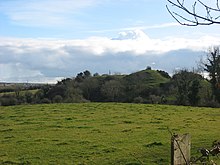| Móta Dhruim Chatha | |||||||||||
 | |||||||||||
 | |||||||||||
| Location | Greenmount, Castlebellingham, County Louth, Ireland | ||||||||||
|---|---|---|---|---|---|---|---|---|---|---|---|
| Region | Dee Valley | ||||||||||
| Coordinates | 53°52′41″N 6°23′09″W / 53.877999°N 6.385855°W / 53.877999; -6.385855 | ||||||||||
| Type | motte | ||||||||||
| Area | 0.7 ha (1.7 acres) | ||||||||||
| Height | 12 metres (39 ft) | ||||||||||
| History | |||||||||||
| Material | earth | ||||||||||
| Founded | 12th/13th century | ||||||||||
| Periods | Norman Ireland | ||||||||||
| Cultures | Cambro-Norman, Old English | ||||||||||
| Associated with | Normans | ||||||||||
| Site notes | |||||||||||
| Excavation dates | 1830 and 1870 | ||||||||||
| Archaeologists | Rev. Joseph Dullaghan, John Henry Lefroy | ||||||||||
| Public access | yes | ||||||||||
| Designation |
| ||||||||||
Greenmount Motte is a motte and National Monument in County Louth, Ireland.
Location
Greenmount Motte is located 2.9 km (1.8 mi) west of Annagassan, overlooking the Dee Valley.
History and archaeology
Motte-and-bailey castles were a primitive type of castle built after the Norman invasion, a mound of earth topped by a wooden palisade and tower.
The motte at Greenmount was formerly known as Droim Chatha ("Battle Ridge", Anglicised Dromcath or Drumcath). A Nicholas of Drumcath (Nicholaus de Dromcath) is mentioned in a documents of 1310 and 1328.
The foundations of an elongated chamber (1.5 × 1 m in size, 5.5 m below the summit) are visible in the bailey.
A scabbard-mount with runic inscriptions (DOMNAL SELSHOFOTH A SOERTH THETA, "Domnal Seal's-head owned this sword") was found in excavation, but it believed to be long pre-Norman, indicating that the motte was constructed on the site of an earlier tumulus. Also found were animal bones, charcoal, burnt earth, a bronze axe and a bone harp peg with friction marks.
Greenmount was a camp ground for Catholic Irish forces in the Irish Rebellion of 1641. It was excavated in 1830, causing a cave-in, and again in 1870.
References
- "Geograph:: Callan Motte (C) dougf". Retrieved 5 September 2016.
- "Journal". 1 January 1874 – via Google Books.
- McNeill, Tom (1 January 2000). Castles in Ireland: Feudal Power in a Gaelic World. Psychology Press. ISBN 9780415228534 – via Google Books.
- "Proceedings of the Royal Irish Academy: Archaeology, linguistics, and literature". Hodges, Figgis & Company. 1 January 1917 – via Google Books.
- Davidson, Hilda Roderick Ellis (1 January 1998). The Sword in Anglo-Saxon England: Its Archaeology and Literature. Boydell & Brewer Ltd. ISBN 9780851157160 – via Google Books.
- Zhulin, Denis Larionov & Alexander. "Read the eBook History of Kilsaran union of parishes in the County of Louth, being a history of the parishes of Kilsaran, Gernonstown, Stabannon, Manfieldstown, and Dromiskin, with many particulars relating to the by James B Leslie online for free (page 2 of 35)".